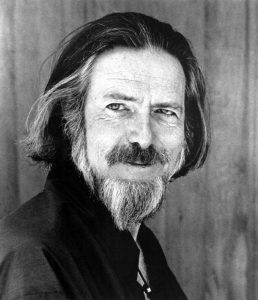How does the process of Destabilisation work and how can we better manage it?
PART ONE
It’s important at definitive moments to feel that we can say what needs, or has, to be said, and, where possible, in harmony with the pervading culture or established context.
The emperor with no clothes
Playing the Devil’s advocate is the antidote when certain things are not meant to be said. Having the freedom to speak and being able to speak openly is the mark of a healthy world. Is the coaching we do a kind of atom bomb dropped next to a person’s flickering candle only to walk away surprised that the candle remains unlit – or has been snuffed out for good? Or does the candle burn brightly and more strongly?
The Sinclair C5

Sir Clive Sinclair famously used the millions made from the Spectrum computer, to put the world’s first electric car onto the production line. His design team wanted to tell him all that was wrong with it, and why it was doomed to failure – but they didn’t.
The paradox is that people are in positions in reality doing the opposite of what they are meant to do or say they are doing. Is this accidental, or by design, or might it be due to fear or confusion or panic? It may even be that they are part of a destabilisation culture, and have no other option, are trapped; or could it be that they are playing a role, wearing a mask, or are sociopaths?
The corporation
Scary as it seems, as the documentary film, “The Corporation”, by Mark Achbar, ably shows, corporations do indeed have a tendency to develop sociopaths, people who can just “perform” without having a moral base. The society of Skinner’s “Walden 2” may really be quite close… It’s this unsettling paradox and sense of incongruence that leads us to feel out of control – even to question our senses at times – and that language is insufficient to express the reality of our own experience.
People today
In a world where the saturation of information is everywhere, knowing who or what is in authentic or in-authentic mode, is well-nigh impossible, apart from by using one’s gut instinct. Where does the needed subjective support come from? …. Let a flock of sheep go into a field and they will not know where to go, except at first as a collective group. Arguably, in primitive times, Mankind didn’t have a strong idea of self; maybe an ancient trauma led to collective amnesia and divorce from a more ‘innocent’ state, after which came the birth of “self” (the ego), and with it, the externalisation of one’s inner voice and the misunderstanding of what this “voice” is. In other words, we began to feel that we are each alone in this life, in some terrible way.
Narratisation and The Westworld
Lisa Feldman Barrett,
in “How Emotions are Made”, has gone so far as to evidence the fact that our emotions are simply psychological constructs expressed in language and have no a-priori existence in a pre-programmed natural way. As Julian Jaynes theorised in his famous book “The Breakdown of the Bicameral Mind” in 1976, the stories we make up in our heads with ourselves as the main characters, are sometimes without reason or purpose; they just ‘are’ and we don’t know why, or what for, except by creating “reasonable explanations” given by other voices within our heads. Thus the ‘knowledge’ that was the inner ‘instruction from the visible gods or invisible God’ of the Greeks and a fter them the monotheists, in the form of a muse or command or ‘story to make sense of life’ broke down and required ever-more complex justifications. This has been brilliantly demonstrated to be the theoretical basis for the entire Westworld series.
fter them the monotheists, in the form of a muse or command or ‘story to make sense of life’ broke down and required ever-more complex justifications. This has been brilliantly demonstrated to be the theoretical basis for the entire Westworld series.
Today, the bombardment of external voices on our consciousness has even greater impact on subconscious processing than ever, therefore, giving time to the processing stage or any activity, and to enabling a good amount of self-composition and mental and physical rehearsal, is critical! Just ‘showing up for the show’ and letting our inner voices take over, is not enough, as any observer of street mind-hacking, of Derren Brown, or close-up magic, knows!!
Politics, society and the mind
A good illustration of this on the collective level can be found in theories of cultural change, as they were developed and then used in psychological warfare and in subversion tactics (cf Babeuf, Levi, Marcuse, Gramschi etc..) and later – in the C20th – for world warfare. Arguably we are still dealing with this.
The negative ‘stages’ of Demoralisation, Destabilisation, Crisis, and Normalisation (all natural emotions that we are forced to pay no heed to, under the stress-control of peer pressure and collective will) have been theorised, developed and practised, for 200 years or more – way back even to Machiavelli. There is a best-selling manual, by R, Greene, the 48 Laws of Power that shows how these tactics are used; “amoral, cunning, ruthless, and instructive, this New York Times bestseller is the definitive manual for anyone interested in gaining, observing, or defending against ultimate control.”
Crisis and how to manage it
Demoralising equates with softening up and bombarding others with information and criticism, it leads to identity loss via the shaming of non-compliance and often we never know why we feel out of sorts. Acts or words are used that are felt as being violent by dint of introducing sudden changes, silencing and censoring, and there may be false narratives claiming problems exist when to all around it all seemed like ‘business as usual’. This can be combined with setting up mechanisms of control, even by blackmail and the use of easy victims & ‘useful idiots’ or via trusted accomplices.
Demotivating – in a very negative sense – is conscious or subconscious agitation (either from within or without) in an attempt to overthrow what is normal; this can be a planned destabilisation in order to take over control. This very real physical problem (of the problem – reaction – solution type expounded in the Hegelian Dialectic) continues with gradual  disempowerment and the imposition of new narrative, culture or set of core values. This can of course be presented as a very positive thing (and may indeed be, while still being received as ‘negative’ to those on the ‘receiving end’) and is further reinforced by the appropriation of education and knowledge. Whereas the intention may to to empower and enfranchise others, disenfranchisement may be the outcome. In many senses, the coach’s work begins here to reverse the impending sense of alienation, by working to re-establish truth and objectivity, establishing the principle of free speech and trust, by bridging differences.
disempowerment and the imposition of new narrative, culture or set of core values. This can of course be presented as a very positive thing (and may indeed be, while still being received as ‘negative’ to those on the ‘receiving end’) and is further reinforced by the appropriation of education and knowledge. Whereas the intention may to to empower and enfranchise others, disenfranchisement may be the outcome. In many senses, the coach’s work begins here to reverse the impending sense of alienation, by working to re-establish truth and objectivity, establishing the principle of free speech and trust, by bridging differences.
Crisis is recognised in confused reactions and more identity confusion, loss of direction, hysteria, blame and so on. There may be internal warfare, both in the collective and in the individual him/herself. The coach here listens and acts to “give responsibility to the other person for their words” and to insist on a clear use of words, and ensures that those that use them, clarify and provide evidence/facts, by then clarify paradoxes, establishing clear  links, and questioning generalisations and unspecified references, deleted information, universals, or others’ presuppositions or patterns of language..
links, and questioning generalisations and unspecified references, deleted information, universals, or others’ presuppositions or patterns of language..
By Normalising we refer to how the “new régime” establishes order after the revolution of ideas. This is done by persuasion, force and – if necessary – the cleansing of cultural or political opposition and the elimination of useful idiots. In the political arena this game is very dirty, yet, and sad to say, the idea of “normalisation” has crept into our vocabulary in more ways that just that of political history. The coach here has a difficult task in liberating one who is at a stalemate or downward spiral, and challenging those who are perceived as aggressors – whether in fact they are the ‘superior’ or ‘inferior’ person in the dominance hierarchy – to think critically; open speech and the freedom to say what is “unacceptable” is very important if this phase is not to explode in the face of the agents of change, and some conscious opposition towards authoritarianism – or utopian thinking – is necessary.
Cui Bono?
Looking at a “positive” side to this can say that the coach works with PERCEPTIONS in language with the ‘aggressor’ (the one perceived to have caused the de-stabilisation) and the ‘victim’ to establish facts in a neutral way, working openly to the idea that the person in question may indeed intend to be aggressive or might benefit from being perceived as a victim. Are they? To whose benefit is it?
PART TWO
To manage destabilisation we need to work on embodied responses.
Embodied states

Stollie makes his way through the weave poles during the agility portion of the Purina Dog Show Incredible Dog Challenge
Since of course the feeling of destabilisation is very much felt bodily as well as mentally, we can work with embodiment practices to better manage the situation.
The work of coaches such as Paul Linden, Mark Walsh, Integration Training, Strozzi-Heckler, George Leonard, and Wendy Palmer, mention the tools and practices that can make it easier to be a skilful listener, a powerful advocator and an inspirational leader. Dylan Newcomb advocates “a new kind of language” – one that speaks to and engages one’s whole mind and body as one dynamic, integrated process. “It’s an embodied practice for self and life mastery”.
We can consider 5 physical axes that lead to better AGILITY
1) vertical (rootedness, having spine and centre),
2) left to right (occupying space, pivoting and having poise and balance)
3) forward and back (distance or urgency/connection)
4) time (and timeliness, allowing reflexion and processing to happen)
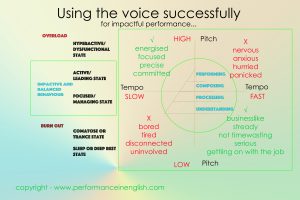
Pitch and Tempo and using the voice to impact performance.
5) voice (entering the space with the right combination of sound, pitch, tempo and rhythm)
Chao-dynamics
Managing crisis implies a radical use of language to oppose the natural tendency to dissipation and destabilisation in complex systems.
Combined with this we may also consider how to mange the language in order to clarify and build bridges, or remove them – as may be necessary for a mutually-beneficial outcome to emerge.
This method is based on a view of human interaction developed from the work of Ilya Prigogine. Viscount Ilya Romanovich Prigogine 25 January 1917 – 28 May 2003) a Belgian physical chemist and Nobel Laureate noted for his work on dissipative structures, complex systems, and irreversibility. Prigogine developed the concept – at the University of Austin in Texas – of “dissipative structures” to describe the coherent space-time structures that form in open systems in which an exchange of matter and energy occurs between a system and its environment. 
The theory of Chaodynamics and Prigogine’s the idea of a what he called a “concentric” approach to nature/communication to reestablish order during a major disruption takes us into the bodily and emotional reactions that infuse the system of both the individual and the environment or collective group.
Work Styles
Stress and the sense that we are opposed in our will, tends to make people revert more and more to a default style, approach or set of rules. Fighting the frame tends to make matters worse! One way out is to provide or explore options; again, it’s often about how these options are framed and what the metaphorical image is.
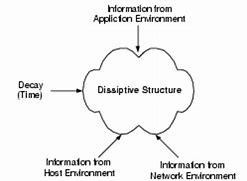
Everything conspires to structure dissipating over time
Jordan Peterson (somewhat unpopularly at times perhaps) asks us to ‘be hard with ourselves’, and to first be ‘welcome in your own house’. By this he means, remembering that even (or especially) the mundane things we do need to be got right. “Being better verbally doesn’t mean that we are right”, he says, referring to how the relationship between one’s belief system and one’s perceived Dominance Hierarchy Position or Confidence Hierarchy is a source of inner struggle, confusion and concerns about status. Why, then, people “need to defend themselves” – even if they may deep down know they are wrong (or perhaps because of this)! – and this demonstrates how social constructivism and politics can’t be separated from language use and the way we embody it.
Perhaps language is our – maybe futile – attempt to make sense of a meaningless world, as Kierkegaard would say.
Your base line state
When a person is reacting to destabilisation it’s important for them to have an awareness of how to access their natural base-line state. Accessing their comfortable state while trying to understand the new state avoids tit-for-tat and self-defensiveness; it means they can start to make sense of things. Embodying a newly generated state may even mean not liking the ‘new person’ that emerges. What that person is, is not for the coach to choose.
The Coach’s role

“Control the options and you control the power” may be good in theory; oftentimes a person is too far from the source of power to feel in any sense capable of restoring order into the chaos. Their only control may be over their own bodies and words in the immediate conversation.
A coach can help another person to be more agile and lucid by means of providing time, perspective, and the opportunity to process a rapidly-evolving situation, and compose themselves for when they need to perform again.
A good starting point might be, ‘what options would you choose/prefer to have when you re-enter the situation?’
Generative Coaching – with no fixed outcomes – or clearly scaffolded?
 We can contrast and Fixed-Outcomes language learning model with the evidence of Natural language acquisition. Stephen Kraschen’s L+1 theory and research show that the time for the acquisition of new models of language (i.e. taking ownership of one’s language given ample processing and self-composition) can be as much as 6 months
We can contrast and Fixed-Outcomes language learning model with the evidence of Natural language acquisition. Stephen Kraschen’s L+1 theory and research show that the time for the acquisition of new models of language (i.e. taking ownership of one’s language given ample processing and self-composition) can be as much as 6 months
ZPD
Another (more scaffolded) approach is that of ZPD. The zone of proximal development, often abbreviated as ZPD, is the difference between what a learner evolving a new skill or prepping a desired outcome, can do without help, and what they can’t do. This concept was introduced (but not fully developed) by psychologist Lev Vygotsky (1896–1934)
The concept of the ZPD is widely used to study children’s development as it relates to education. The ZPD concept is seen as a scaffolding, a structure of “support points” for performing an action, referring to the help or guidance received from an adult or more competent peer to permit the child to work within the ZPD.
 The “scaffolding” – of which coaching is perhaps just one part – consists of a variety of supports. These supports may include: resources, such as a compelling task; templates and guides; specific guidance on the development of cognitive and social skills; and finally the use of instructional scaffolding in various contexts when modelling a task and the approach to solving the task, by giving advice and providing coaching.
The “scaffolding” – of which coaching is perhaps just one part – consists of a variety of supports. These supports may include: resources, such as a compelling task; templates and guides; specific guidance on the development of cognitive and social skills; and finally the use of instructional scaffolding in various contexts when modelling a task and the approach to solving the task, by giving advice and providing coaching.
Since the aim is for the client to reach an embodied state of readiness where he/she is able in the present to “bring forward the emerging future” these supports are gradually removed as students/coachees develop their own autonomous learning strategies. In this way the coach becomes less necessary, thus promoting the client’s own cognitive, affective and – critically – psychomotor learning skills and knowledge.
Just as in the educational taxonomy, where teachers help the students master a task or a concept by providing support, so coaches can provide scaffolding support. The support can take many forms such as outlines, recommended documents, storyboards, or key questions.
Yes, master
In some cases (and cultures) the coach is viewed as a master communicator of language – not specifically one who has all the answers, more one who can empower the client to find them. Scaffolding works as the good coach  makes themself “progressively less necessary” and the building eventually stands up alone.
makes themself “progressively less necessary” and the building eventually stands up alone.
Trusting overly in the coach’s input can however lead to further destabilisation.
The key to embodiment (what NLP calls “anchoring states”) is in doing things in a real embodied environment, and not a BOOK environment.
Or, as Alfred Korzybsky said, “the map is not the territory”.
This then is the area of interest between the linguistic insights of language acquisition, and of coaching, and points to how a generative approach can work, to which we will return…..
Types of scaffolding
For scaffolding to be effective, attention can be paid to the following:
-
The selection of the task: The task should ensure that learners actually use the developing skills that they want to master. The task should be engaging and interesting to keep them involved!
-
The anticipation of errors: After choosing the task, the teacher/coach might anticipate “errors” that are likely to be committed when working on the task. In outcomes-based education, anticipation of errors enables the scaffolder to properly guide the learners away from “ineffective directions”. When the outcome is fluid and unknown, however, “errors” are for the coachee, student or client alone to determine for themselves.
-
The application of scaffolds during the learning task: Scaffolds can be organized as simple/discreet skill acquisition – or they may be dynamic and generative.
-
The consideration of emotive or affective factors: Scaffolding is not limited to a cognitive skill but also relates to emotive and affect factors. During the task the scaffolder (implied expert) might need to manage and control for frustration and loss of interest that could be experienced by the learner. In this way encouragement is an important scaffolding strategy.
In terms of scaffolding again we can consider:
-
conceptual scaffolding: helping students/clients decide what to consider in learning so as to guide them (or for them to guide themselves) towards key concepts
-
procedural scaffolding: helping the student or coachee to use appropriate tools and resources effectively
-
strategic scaffolding: helping to find alternative strategies and methods to solve complex problems
-
metacognitive scaffolding: prompting to think about what is being learnt throughout the process and assisting reflection on what was learnt (self-assessment).
Other approaches and their relevance to our argument.
From Sir John Whitmore’s GROW, to SMART, many models exist; few however, which touch more on communications and language performance or how to embody this. The Transitional Curve lends useful support as a concept, and Hamlin’s HP equation, Ability x Motivation x Environment, adds the idea that our cognition, commitment and communicative credibility are important. The Contracting Matrix show that it is important to be clear, and adapt our behaviour, and I personally find the Jonari window helpful when working through blind spots and the “dark side” or other more public revelations. Of course, having a clear focus, on options and an action plan, and a way of overcoming obstacles, is always valid, along with the insights given by cross-cultural models and people potential profiles.
In communicative method language training the outcomes-based model used, is along the lines of elicitation -> presentation -> controlled practice -> free practice -> testing and assessment (coupled with copious scaffolding). This approach can be useful when working with new language but tends not to develop real acquisition.
In NLP, the iterative problem-solving strategy TOTE (Test Operate Test Exit) as well as Meta-model and Milton-model approaches to change states, presuppose the subconscious mind’s capacity to find resources that will shift perceptions and abilities, and these bring out subconscious discoveries.
In a generative coaching approach this would likely involve conscious distraction and re-framing by relocating the experience within the physical environment in different ways, and accessing the embodied reactions, as well as giving a lot of time to rehearsal and self-composition, treating ourselves meditatively. It would allow for a less-guided style that is open-ended and creative.

North-West artist Matt Wilde has described how he is concerned with capturing the ‘immediacy’ of those surroundings that people become immersed in. “His technique of applying the paint quickly to the canvas in a perhaps more sketch-like manner lends itself to the fast-paced lifestyles of today’s society that Matt is eager to convey. There is often humour and wit in the scenes that Matt reveals to us, but he also captures those moments of human isolation in the contrasting chaos of busy city life.”
Agility
We look for examples of a physical response when using language in performance. We think about what the voice expresses and where in the body that voice emanates from. The “hook” of the downward spiral can be considered as an “inner terrorist” and is a very unpleasant sensation that affects the body seriously; words are powerful and may in some cases suffice to disarm the perceived threat or to change one’s perception of it; more often, an embodied approach (giving more time for rehearsal and self-composition) will help in ensuring that the intended outcome is a genuinely good performance willed by the person in question and congruent with their sense of best interest.
If the outcome is not pre-determined, then it emerges through language which is always new, and actions that feel right. Life is not a constant prepping for a “test”, so the process and composition and creation of new actions and words are both physical phenomena.
Hence to embody the outcome is to have lived it inwardly and mastered it outwardly, in numerous physical ways, first.




















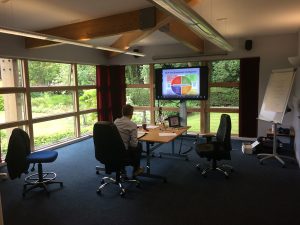

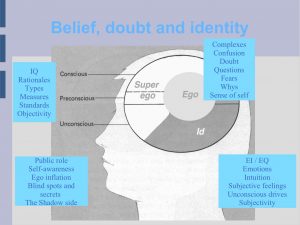
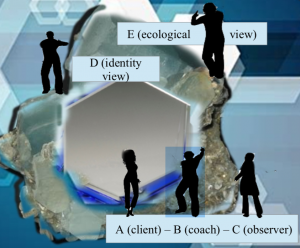





 fter them the monotheists, in the form of a muse or command or ‘story to make sense of life’ broke down and required ever-more complex justifications. This has been brilliantly demonstrated to be the theoretical basis for the entire
fter them the monotheists, in the form of a muse or command or ‘story to make sense of life’ broke down and required ever-more complex justifications. This has been brilliantly demonstrated to be the theoretical basis for the entire 

 disempowerment and the imposition of new narrative, culture or set of core values. This can of course be presented as a very positive thing (and may indeed be, while still being received as ‘negative’ to those on the ‘receiving end’) and is further reinforced by the appropriation of education and knowledge. Whereas the intention may to to empower and enfranchise others, disenfranchisement may be the outcome. In many senses, the coach’s work begins here to reverse the impending sense of alienation, by working to re-establish truth and objectivity, establishing the principle of free speech and trust, by bridging differences.
disempowerment and the imposition of new narrative, culture or set of core values. This can of course be presented as a very positive thing (and may indeed be, while still being received as ‘negative’ to those on the ‘receiving end’) and is further reinforced by the appropriation of education and knowledge. Whereas the intention may to to empower and enfranchise others, disenfranchisement may be the outcome. In many senses, the coach’s work begins here to reverse the impending sense of alienation, by working to re-establish truth and objectivity, establishing the principle of free speech and trust, by bridging differences. links, and questioning generalisations and unspecified references, deleted information, universals, or others’ presuppositions or patterns of language..
links, and questioning generalisations and unspecified references, deleted information, universals, or others’ presuppositions or patterns of language..






 We can contrast and Fixed-Outcomes language learning model with the evidence of Natural language acquisition. Stephen Kraschen’s L+1 theory and research show that the time for the acquisition of new models of language (i.e. taking ownership of one’s language given ample processing and self-composition) can be as much as 6 months
We can contrast and Fixed-Outcomes language learning model with the evidence of Natural language acquisition. Stephen Kraschen’s L+1 theory and research show that the time for the acquisition of new models of language (i.e. taking ownership of one’s language given ample processing and self-composition) can be as much as 6 months The “scaffolding” – of which coaching is perhaps just one part – consists of a variety of supports.
The “scaffolding” – of which coaching is perhaps just one part – consists of a variety of supports. 
 makes themself “progressively less necessary” and the building eventually stands up alone.
makes themself “progressively less necessary” and the building eventually stands up alone.


